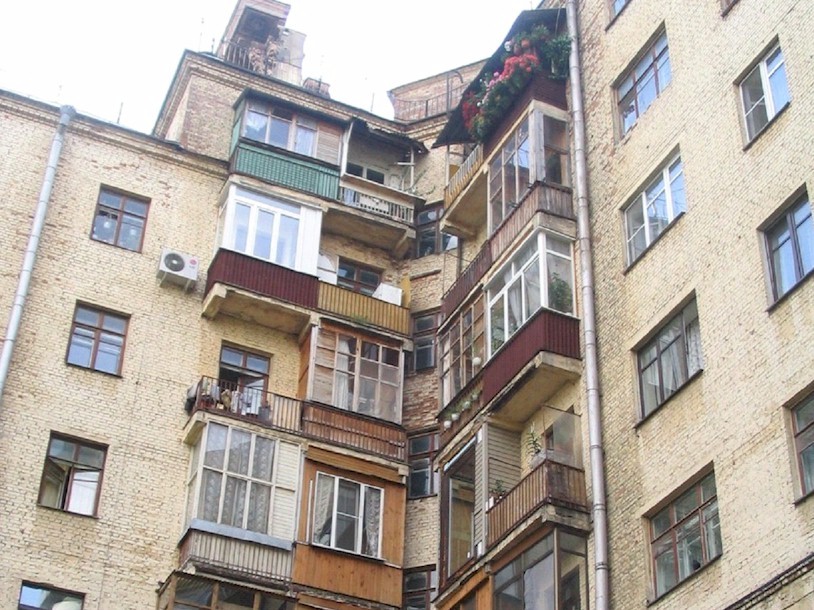Мы продолжаем напряженно работать, чтобы улучшить наш сайт и перевести его на другие языки. Русская версия этой страницы еще не совсем готова. Поэтому мы представляем здесь пока английскую версию. Мы благодарим вас за понимание.
Размещение в Советском Союзе
In chapter 18 of The Master and Margarita, we can read how Maximilian Andreevich Poplavsky, Berlioz’ uncle by marriage who is living in Kiev, comes to Moscow to claim his nephew's housing. It was a common scenario during the Soviet period, since getting an apartment in Moscow was considered as a great victory. Moscow had goods that could not be found anywhere else. However, to gain a прописка [propiska] - a registration or permit to live there, was not easy, as Poplavsky would soon understand.
The collectivization of living space
Private ownership of houses was abolished in the Soviet Union in 1918. New laws came into effect governing who could live where. The situation was particularly complicated in the cities, where landowners fled and many people moved to the cities. The resulting housing crunch has effectively lasted to this day. Housing authorities were set up to determine who should live where. Most apartment buildings had a Housing Committee headed by a House Manager. A very lively example of how it worked can be seen in the movie picture Doctor Zhivago (1965), directed by David Lean and based on Boris Pasternak's famous novel.
Another movie picture portaying this problem beautifully is [Est] Ouest (1999) directed by Régis Wargnier, of which you can watch a fragment here.
Any apartment deemed too large for its tenant, if the tenant was lucky enough to be allowed to remain, was forcibly shared with whoever the Housing Committee authorized to move in. Often, large apartments and private houses were remodeled into several smaller apartments. Other apartments were simply shared. For example, a three-room apartment that belonged to one family would now by decree become a three-room apartment for three families. Kitchen, hall, and bathroom were shared. Often there would be resentment between the various families living in one so-called коммунальная квартира [kommunalnaya kvartira] or communal apartment, especially if one of the families was the original owner, and especially if all families continued to live together for years.
The typical Soviet reaction to the hardship was to think up clever schemes to get around the official regulations. The apartment exchange was a case in point. If, for example, two people married, they might want to exchange their two one room apartments for one two room apartment. The simplest way might be to find another couple who were divorcing and switch with them. Of course, all this had to be approved by the Housing Committees of each apartment building. Usually the situation was more complex: perhaps a third or fourth family would be involved, with family three moving into apartment one, and family four moving to apartment three, and so on. Inequities in terms of the size and quality of the apartment and the desirability of the neighbourhood had to be taken into account. Sometimes some parties could be paid off in some way to accept a less desirable living situation. Another trick was to divide an apartment with large rooms into smaller rooms, which might make it more desirable, at least on paper. Such machinations endured into the last days of the Soviet Union.
The New Economic Policy
In 1921, small houses were returned to the former house-owners. But all land was nationalized, so the owners of small houses retained possession only of the buildings but could use the plots on which the building rested. The possession was limited to personal use of the former owner and his family. During the period of the New Economic Policy (NEP) private persons were allowed to build and possess small houses.
In 1936, article 6 of the USSR Constitution said: «The land, its natural deposits, waters, forests, mills, factories, mines, rail, water and air transport, banks, post, telegraph and telephones, large state-organized agricultural enterprises (state farms, machine and tractor stations and the like) as well as municipal enterprises and the bulk of the dwelling houses in the cities and industrial localities, are state property, that is, belong to the whole people.»
Though article 10 of this same Constitution said that «The right of citizens to personal ownership of their incomes from work and of their savings, of their dwelling houses and subsidiary household economy, their household furniture and utensils and articles of personal use and convenience, as well as the right of inheritance of personal property of citizens, is protected by law.»
Nevertheless, the private plot remained in the eyes of the government and the party a concession, an evil which had to be eliminated as soon as possible.
Social justice
In 1939, having succeeded in taking away nearly all the private farms, the Soviet government, by an odd contrast, adopted the policy of encouraging individuals to own their own houses. But only few, particularly party nomenclature, and those close to the power, could dream about the high quality, decent dwelling.
The principle of social justice, as it was understood in the USSR, stated that every family had the right to a dwelling of not less than 5 square metres of living space per person. For example, if a family of three persons had a 15 square metres room in a so-called коммунальная квартира [kommunalnaya kvartira] or communal apartment, it was estimated to be enough for them. But if the room was only 14 square metres, they received the right to improve their living conditions and were included into a waiting list for a new flat, granted from the State. These people were called Очередники [ocheredniki]. Some ocheredniki had to wait for several years, in Moscow and Leningrad it could easily be 10 years or even more.
At that time almost all housing stock in the cities belonged to the state. The state ran, maintained and constructed the houses. But despite the increasing volume of constructions, there was a permanent housing shortage, the waiting lists became longer and longer and corruption and officials' voluntarism prospered.
Those who were lucky to receive a separate flat became neither owner nor renter, but tenant, they had no tenancy agreement, but only the permission to occupy the flat - a прописка [propiska]. All the housing rights were fixed in the Housing Code. The tenants were not supposed to pay rent, they only had to pay for the utilities, which were limited and controlled by the State. The housing system was one of the most unmarketable in the Soviet economy, and utility tariffs were far from the real expenditures. Up to the nineties, the residents paid not more than 10 % of the real cost. The rest was the responsibility of the state. It was not too strange, that the permanent financial shortage caused ramshackling of the housing stock, engineering systems and infrastructure. Non adequate payments for the resources caused irresponsible waste of water, electricity and gas.

Typical balconies of flats in Moscow
Housing in the Russian Federation
The Perestroika opened new opportunities for the denationalisation and market reforms in all areas of Russian economy. In the early nineties the reforms reached the housing market too. In 1992, the Federal Housing Privatisation Law confirmed the private tenants’ ownership of the flats they were occupying. The dwellings were transferred for free to all who wanted it. But only once, and only according to their propiska. Of course, the best and most expensive apartments were given to nomenclature and the rich, who had the widest opportunities in the Soviet system. In other words: the housing privatisation legalized the former soviet distributing system and increased the abyss between the rich and the poor.
In application of the Housing Privatisation Law almost 50 % of the national housing stock was privatised. It was one of the most significant political actions of the new Russian Government. Russia, at 71 %, has now an even higher home ownership rate than the USA (68 %), the United Kingdom (69 %), Canada (66 %) or Belgium (65 %).
But it didn’t lead to the expected economic consequences. The majority of the new flat owners had received new rights (to sell, to donate, to inherit), but they were not ready to manage their property, nor to pay for maintenance. The authorities were compelled to continue to subsidise the housing, by limiting the utilities tariffs and thus supporting both poor and rich residents. Besides this, a system of personal subsidies for the poor was developed: a family should not pay more than 18 % of the monthly income on housing expenditures. The rest is at the State's cost. This financial burden is heavy for the local budgets. The housing support leads to a significant shortage in budgets (in the year 2000 this shortage was 59 billions roubles). The consequence of this policy is an ongoing tendency to unstability and decreasing reliability of the housing infrastructure.
Along with the privatisation of housing, former state companies became private management and constructing enterprises. Nowadays the state and local authorities do not construct housing any more. Private investment and private construction companies have taken over this sector.




